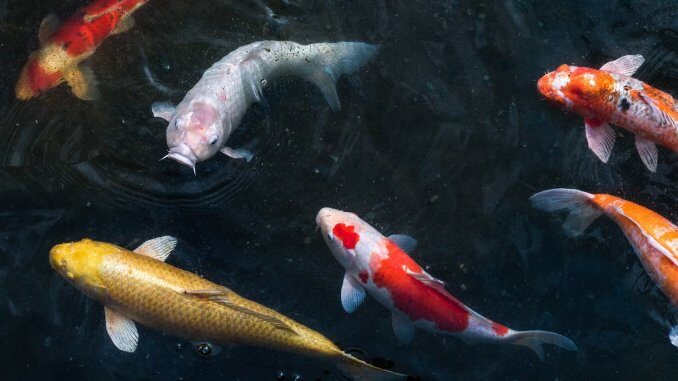
If you know someone who has a pond, chances are they keep a couple of Koi to brighten it up.
Koi fish are some of the most common, well-known fish to keep in outdoor garden ponds.
In Japan where they were first bred, they are highly prized and are even the main subjects of many myths and artwork.
Although they are directly related to goldfish, it would be a big mistake to assume that they have the same level of care. These fish could never live in a tank, they need an outdoor pond.
Do you think you are ready to open your pond to a few Koi? Read on to discover the best possible way to care for these gorgeous, long-living carp.
TABLE OF CONTENTS
Koi Fish Facts & Overview
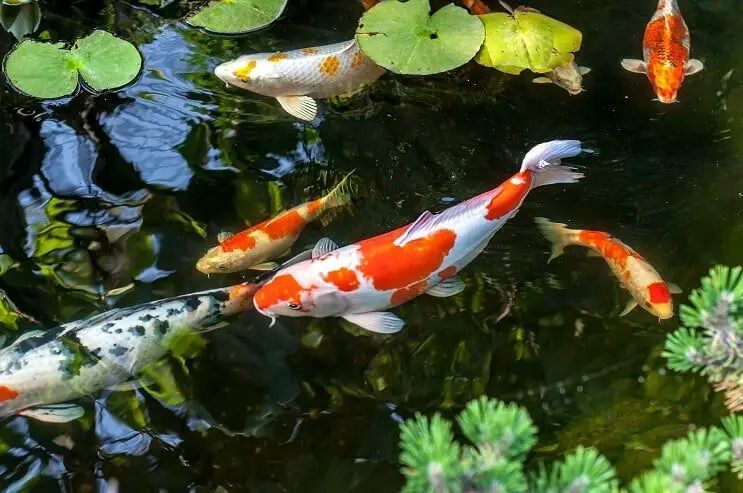
| Category | Rating |
| Care Level: | Intermediate |
| Temperament: | Peaceful |
| Color Form: | Typically white or silver with red, gold or orange markings |
| Lifespan: | 30-50 years |
| Size: | 24-36 inches |
| Diet: | Omnivore |
| Family: | Cyprinidae |
| Minimum Tank Size: | 250 gallons |
| Tank Set-Up: | Heavily planted outdoor water garden |
| Compatibility: | Other carp, game fish, and amphibians |
Koi fish are ornamental variations of the common carp (Cyprinus carpio). They belong to the family Cyprinidae, which includes all carps and minnows.
The word Koi comes from the Japanese word for carp.
Keeping and breeding Koi began in 19th century Japan when farmers kept colorful specimens of the native carp in their rice gardens.
Now the keeping and breeding of these fish is a widespread and lucrative industry.
Unfortunately, the popularity of these beautiful fish has led them to become invasive in waters all over the world.
In the wild, common carp only live for about 20 years due. But captive Koi can live up to 50 years if they are cared for properly.
Common varieties found in most backyard ponds can be purchased from pond and aquarium suppliers for anywhere between $50 and $80.
Special varieties must be purchased from a breeder – these can be very expensive, ranging from as low as $200 to as high as $1000+.
Typical Behavior
Koi are very peaceful fish that will interact with the others in their school while leaving that outside of their school alone.
They form schools of anywhere between 5 and 15 individuals and will swim in beautifully coordinated formations.
Koi will visit every level of your pond. They will swim and dart along the surface and middle levels and forage for natural foods at the bottom.
In colder temperatures, they will shelter at the deeper levels of your pond.
They are very active and free-swimming fish that will show off their vibrant colors at every opportunity.
Koi fish have a rather interesting way of hunting for food.
When foraging, they will dig and burrow into the sediment to uproot plants and munch on tasty seeds.
They eat like a vacuum, taking in big gulps of food and filtering out the dirt and mud.
This is a rather unusual feeding strategy that makes them a major pest to freshwater ecosystems.
Types
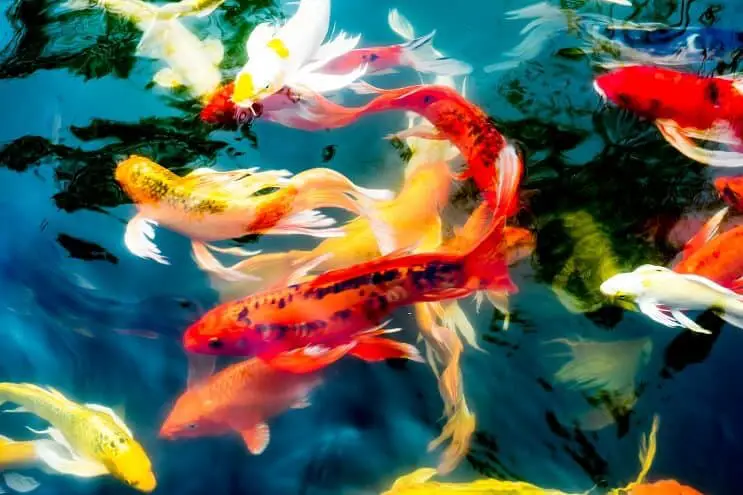
Koi fish can reach lengths of up to 3 feet – they are one of the largest cyprinids and one of the largest fish commonly kept in backyard ponds.
They generally have two barbels on both sides of the jaw and have a round snout and a toothless jaw for taking in gulps of prey.
Females are larger and have rounder bodies than males. Typically, their fins are short and rounded, with lobed caudal fins. However, certain varieties are bred for their long trailing fins.
These gorgeous fish come in striking colors. They are typically white or silver, with iridescent scales and colorful spots and markings.
These markings can be red, gold, orange, black, or even deep blue.
Their exact color and markings depending on the type.
Butterfly Koi Fish
Butterfly Koi (also known as Dragon Koi) are named after their long pectoral and caudal fins. They are highly prized and valuable to keepers.
This variety can be found in any of the typical color forms and is only set apart from others by the length of its fins.
Japanese Koi Fish
These are the most common Koi that you will see in most ponds and water gardens.
Kohaku Japanese Koi are white with orange/red markings. They are considered the standard variety.
Tancho Koi are Kohaku Koi with a single red spot on the top of the head.
Dragon Koi Fish
The dragon can refer to two different kinds of Koi. More often, it’s just another term for the Butterfly Koi.
The Kumonryu variant is also referred to as a Dragon Fish. This is a black and white fish with markings that change depending on the seasons.
Black and White Koi Fish
Shiro Utsui fish are white with black spots and markings. Some have a split-head pattern with white on one side of the head and black on the other.
Matsuba Koi can be black and white as well, but can also have black markings over a red or gold body.
Gold Koi Fish
Ogon is a highly prized one-color variety. An Ogon fish is entirely silver, orange or gold.
Typical Koi with gold markings over white bodies are called Ki. Kinrin fish have beautiful scales that sparkle like gold coins.
Habitat and Pond Conditions
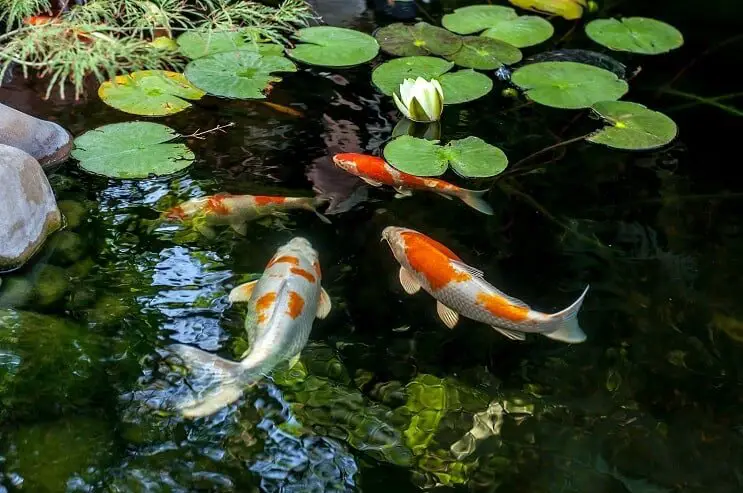
The Koi’s wild counterpart, the common carp, is native to Europe and Asia.
They live in lakes, ponds, and streams with muddy bottoms and minimal flow. It is found in both temperate and tropical areas and prefers water temperatures above 70°F.
It is most active in the dimly-hit hours at dusk and dawn but will swim and forage during all hours of the day.
Replicating these conditions in your pond is not a difficult task.
Koi Fish Pond Setup
Your garden pond should maintain temperatures between 74-86°F all year round. In the winter, a heating system will be needed to prevent any freezing.
Water flow is not necessary, but the fish will be just fine if you choose to add a small stream or waterfall to your pond.
The pH of your pond should be kept between 6-9. You can use crushed limestone in your water can help to maintain your pH.
Your pond should be made from concrete, with a rubber lining and muddy bottom substrate.
The very best setup for Koi is a beautiful outdoor water garden, complete with non-invasive plants that will not damage your natural ecosystem.
The best plants for a water garden includes:
- water hyacinth
- water lilies
- cattails
- pickerels
- floating pondweed
- duckweed, and more
Many keepers plant willows and other shady, trailing trees around their water garden. This helps to provide extra shade and cover for your fish.
What Size Pond Do Koi Need?
Koi need at least 250 gallons of water. A school of large Koi will require up to 1,000 gallons.
Your pond should have a minimum depth of at least 6 feet and include both shallow and deeper areas.
The rule of thumb with these fish is to keep 10 gallons of water for every inch of fully grown Koi.
This means 250 gallons of water for one adult fish.
Pond Mates

In the wild, these fish live among other carp species. They can also be found alongside smaller Minnows and Killifish.
They are found in lakes and streams that have large game fish like Catfish, Perch, and Bass.
Koi are very peaceful fish that will not harass or prey on the other fish in your pond, so there are quite a lot of options for stocking.
Goldfish are one of the most popular pond mate choices. They are similar in color and appearance and look beautiful when they swim alongside one another.
Grass carp serve as great tank mates and natural pruning systems for your pond – they have a huge appetite for vegetation and will help to trim down any plants that might be growing out of control.
Sunfish do very well alongside all kinds of carp – Redear sunfish are a particularly popular choice for stocking a carp pond.
Other good pond mates include Catfish, largemouth bass and striped bass. Be aware that the bigger game fish will require a larger pond size.
Amphibians (particularly Frogs) make the best non-fish pond mates. You can encourage the local Frogs, Salamanders, and Newts to drop by for a visit.
It is best to attract frogs naturally to your pond, rather than to stock your pond with frogs.
Frogs from pet shops or other ponds may be carrying bacterial infections that can spread to your fish.
You should avoid keeping bluegill with any kind of Carp. Bluegill and Carp are natural rivals and they can be very destructive to your garden when competing for food and resources.
Small Cyprinids classified as nano fish should be avoided as well. These fish are often very anxious in the presence of large tank mates.
Keeping Koi Fish Together
Koi are at their best when they are in a group. They should be kept in schools of at least 5, and in larger ponds, you can keep up to 15 individuals.
Care
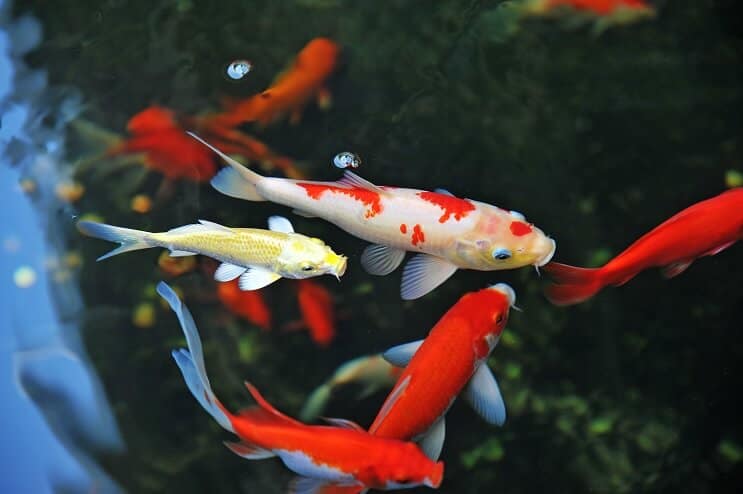
Koi are susceptible to a fatal herpesvirus. Koi herpesvirus, or KHV, is a contagious virus that affects all varieties of the common carp.
Once a fish has been infected, there is an 80 percent chance that it will die from the illness.
Death occurs as quickly as a day or two and any fish that survive the infection become permanent carriers that can infect other carp in the pond.
Symptoms of KHV include breathing difficulty, sunken eyes, and red and white lesions at the gills. In many cases, the whole population must be euthanized once one fish is infected.
KHV can be prevented by carefully inspecting the health of any new carp that you introduce to your pond. New fish should be quarantined for up to 2 weeks before you place them in your pond.
Other illnesses and parasites that affect Koi fish include fish lice, ich, and ulcerative diseases that affect goldfish and other carp.
Watch for erratic or uncoordinated swimming, lethargy, or breathing difficulty. Your fish will gulp at the air if it is having trouble breathing.
Even though these fish have a very high tolerance for poor water quality pond maintenance is the most important aspect of care and disease prevention.
You should clean the pond and check your filter every 2 to 4 weeks.
Diet
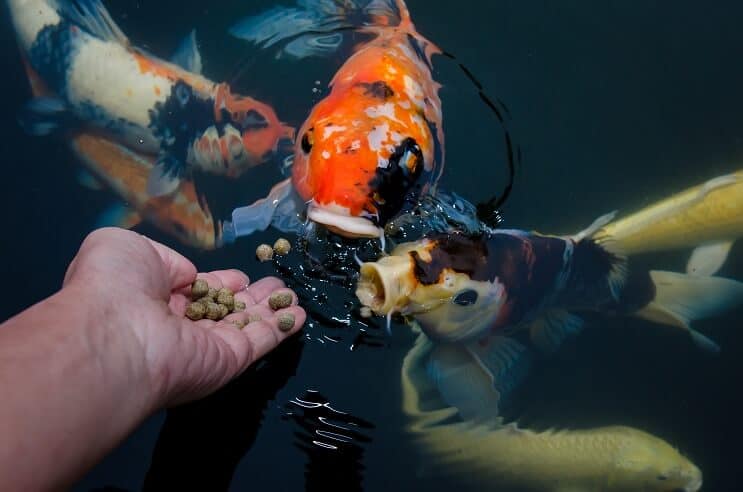
In the wild, these fish are known for their huge appetites and have a similar diet to goldfish.
They are omnivores that eat seeds and plant material, algae, zooplankton, and insects. They do not prey on other fish but may eat their eggs.
In a well-stocked pond, your fish will find vegetation and critters to munch on. The best diet for them includes an even mix of both natural and commercial foods.
They will readily eat algae and aquatic plants. You should keep a good stock of algae and floating weeds in order to discourage them from uprooting the plants in your water garden.
To satisfy their love of zooplankton, introduce water fleas and brine shrimp to your pond. You can also give them insects and insect larvae purchased from an aquarium supplier or bait shop.
Any commercial foods you give them should be high in protein. They will feed at all levels of the pond and can be given pellets that will reach all depths. You can supplement their diets with farm grains such as rice and corn.
The majority of your Koi’s nutrition will come from what they find in your pond. You can give them up to 3 small portions of additional pellet food per day.
An automatic fish feeder set for twice a day works wonders for most pond fish.
Breeding
Breeding Koi fish will require a separate pond for mating and spawning.
It can be done naturally or induced through artificial means such as hormone injections. The fish will reach sexual maturity between 2 and 5 years old and natural breeding will occur in the springtime.
In a breeding pond, there should be 2-3 males for every female. Larger, older females are the best spawners.
To encourage natural breeding conditions, keep your breeding pond at temperatures between 64-72°F.
They should be fed food high in protein and include both natural and commercial foods, up to 3 times a day.
Females will lay their eggs in your shallow-water vegetation, and the male will fertilize them once they are laid. This kind of external fertilization occurs in many different species of fish.
Once the eggs are fertilized, they must be removed and placed in an incubation tank. They will hatch in 3 to 4 days.
Your newborn fish will not look like much. In the larval stage, they are extremely tiny and will drift through the water like zooplankton.
Once they reach the fry stage and lose their yolk sacs, they will look like very tiny scale-less fish.
Fry can be reared in an indoor tank until they reach the juvenile stage. They should be fed larval brine shrimp and hardboiled eggs mixed with water.
Once they reach the juvenile stage, they will look just like miniature versions of adult fish. They can then be placed in the pond and given the same foods that you give the adults.
Are Koi Suitable For Your Pond?
There is a reason that Koi fish are one of the most popular choices for garden ponds. They are a lovely addition to an outdoor pond and are not as difficult to care for as other large pond fish.
They are a favorite of fish keepers and gardeners alike and provide the perfect addition to any water garden. With so many beautiful colors to choose from, you can be sure to find just the right fish for your garden.
Beginner fish keepers should start off with the more common Koi varieties before attempting to take on more expensive breeds.
If you are properly committed to the task, caring for these fish will be a fishkeeping experience like no other!
What is the most rewarding part of keeping Koi? Let us know in the comments section below…

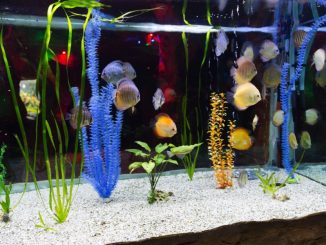
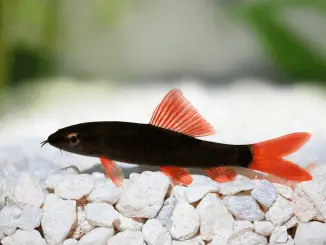
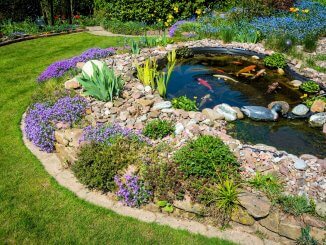
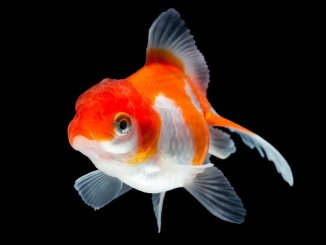
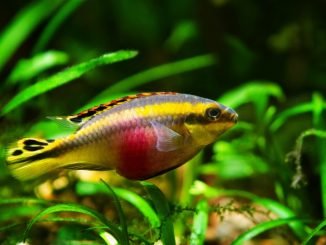
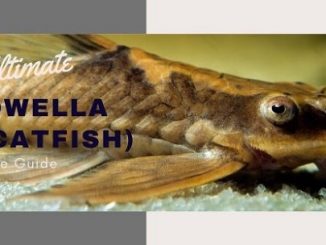
I had a pond for several years and had no problems in keeping my koi. But recently my fish are not eating the pellets (floating) which I have been giving them regularly. I would like some advice as to what to do.
My family has been raising and keeping giant Koi fish for more than 35 years. I started off with a half dozen juvenile 2″ Koi from a well known local breeder/supplier and a dozen fancy goldfish at the same time. 5 years later I bought a dozen more juvenile Koi with some fancy rarer breeds in the mix, the Koi have since bread many times over through the years. Some of our 35 year and older Koi are 34″ long and weigh in over 25lbs! The pond has water features, blocks, ledges, shady secluded, shallow and open deep areas. There are rockscapes in the lawn and around the pond all with a natural stone waterfall as the central feature. Areas with water lily pads, reeds and other aquatic plants need to be sheltered from the Koi or they will uproot, dig into or eat them and you can lose your aquatic plants. Planted along the south edge of the pond is a Japanese apple tree that offers partial summertime shade for high noon heat periods. Having partial high & afternoon shading is important for pond water temperature regulation. The oval shaped pond is approximately 1,200-1,500 gallon capacity, 4-4 1/2ft deep, It is made of concrete and natural rock that has a plastic liner within the concrete formed shape and sunk into our backyard lawn. Having a pond this size easily supports more than 15 full grown giant Koi, a half dozen 6-14″ fancy goldfish along with a large 12″ diameter shell aquatic turtle all as full-time residence. Frogs & other aquatic life frequent the pond area in early spring and the summer time. The Koi eat insects and honey bees that come to a particular porous rock for water in the height of summertime adding to the Koi protein diet. Koi also enjoy sucking the algae growing along the waterline. They are fed Koi specific pond food pellets I purchase in 50lb sacks at a time and whole-wheat Cheerios breakfast cereal bought in bulk. The turtle eats the cereal as a favorite food along with the Koi pellets and what is found at the bottom of the pond any rotting and decayed organic matter. The pond requires very little maintenance with a separate skimmer fed gravel sump filter that finds organic bacterial balance and equilibrium for crystal-clear waters. Only a once-yearly fork over of the gravel bed and weekly back-flush valve to maintain equilibrium of the ecosystem that takes less than 30 seconds time and helps to fertilize our lawn. Recently, I have had to build a barrier with a bi-level electrified wires around the pond because of predator birds and raccoons that target the Koi at nightfall. This has virtually eliminated poaching as I have lost a half dozen prized Koi prior to installation of the electrified wires and bird netting. Motion security LED lights that shine around the pond area when movement is detected in the vicinity has also helped prevent any further losses.
Our neighbors, friends and children find it very enjoyable to watch the Koi swim about and the turtle crawl along the bottom of the pond. It has given me great peace and tranquility in a very busy life. We have a 40 gallon tropical fish tank in our kitchen area where I raise the young Koi until they will not be eaten by the full-grown adults and are big enough to survive when I find them in the pond as newly hatched.
All in all, a most rewarding hobby that adds beauty to your backyard oasis.